Construction Financial Projections are crucial tools for builders, investors, and stakeholders in the construction industry. These projections provide a forward-looking view of a construction project’s expected financial performance. By forecasting revenues, costs, and potential profits, they offer valuable insights into a project’s feasibility and profitability. Properly developed and analyzed, these projections can mitigate risks, guide decision-making, and attract funding. Given the variable nature of construction projects—with shifting timelines, unexpected expenses, and market fluctuations—it’s essential to have accurate and dynamic financial forecasts to ensure sustainable growth and success.
5+ Construction Financial Projections Templates
1. Construction Financial Projections Template Bundle
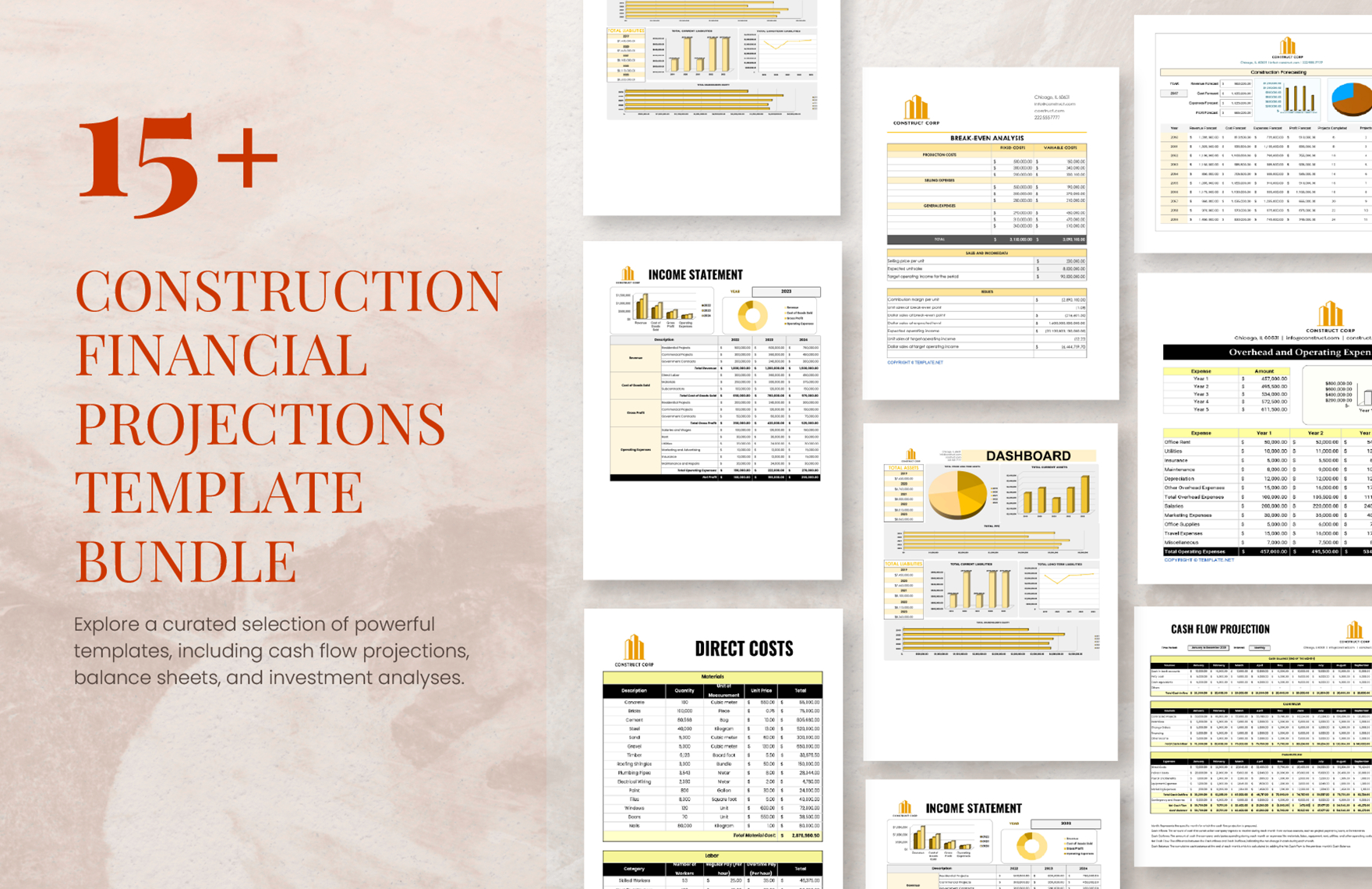
2. Construction Financial Forecast Template
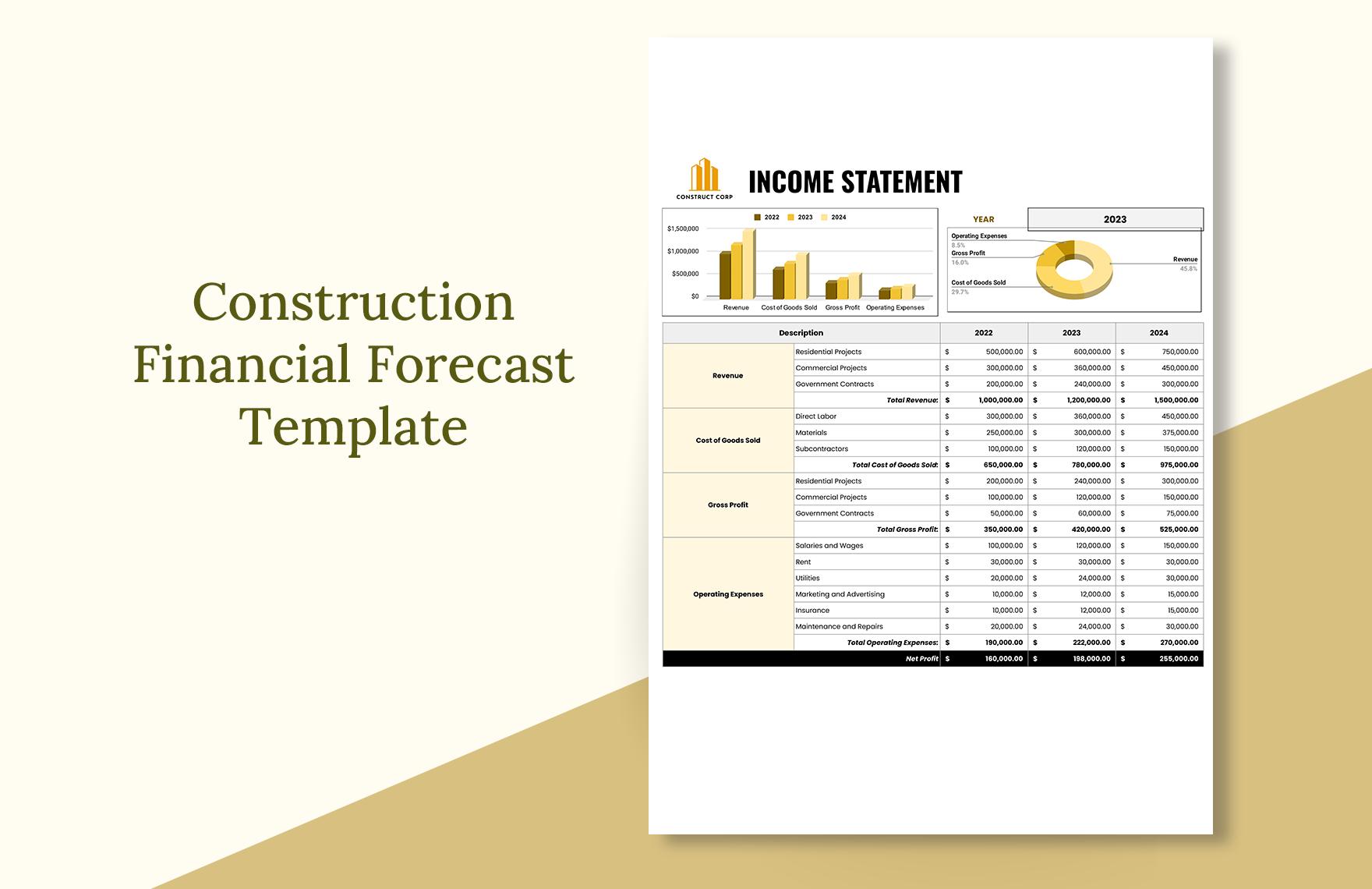
3. Cash Flow Projection Template
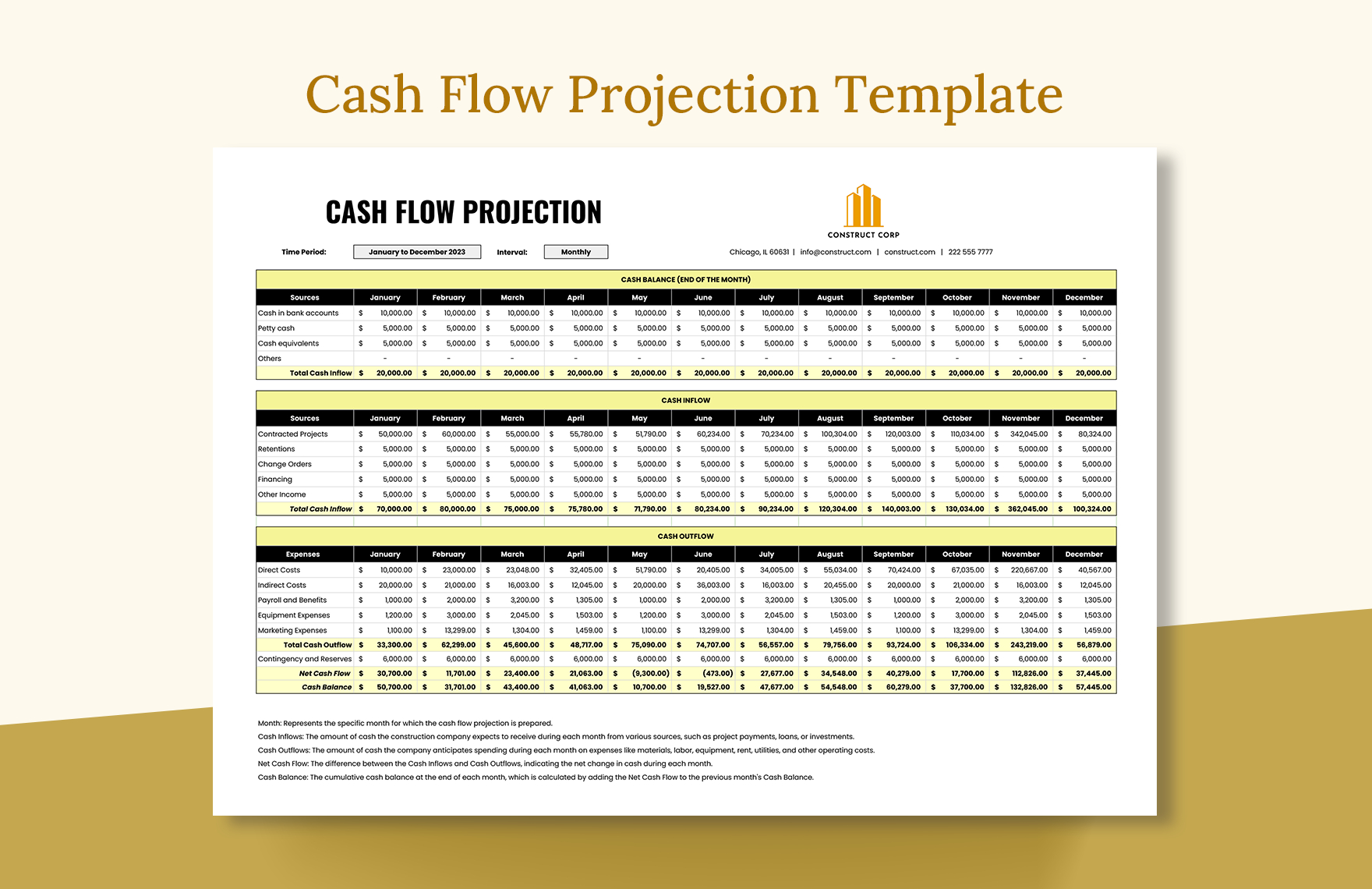
What is Construction Financial Projections?
At the intersection of ambition and financial prudence in the construction realm lies the art and science of Construction Financial Projections. Like the foundation to a skyscraper, these projections give stability, direction, and vision to construction ventures, ensuring they stand tall amidst challenges.
The Role of Financial Projections in Construction
Every construction project, be it a residential building, a commercial complex, or an infrastructure project, is grounded in numbers. It starts with a vision, but for that vision to materialize, one needs a sound construction business plan. Central to this plan is the Construction Financial Projections, a roadmap that forecasts the financial journey of the project.
Cash Flow: The Lifeblood of Construction
A construction project without a consistent cash flow is like a vehicle without fuel. Cash flow projections ensure that there’s enough liquidity at every stage of construction. It helps in maintaining a steady pace, paying suppliers, meeting operational costs, and ensuring smooth progress.
The Essence of Financial Modeling
This is where financial modeling comes into play. By leveraging tools like Excel, financial experts can weave intricate models that provide a glimpse into the future. These models account for numerous variables, trends, and potential scenarios, enabling businesses to make informed decisions.
Financial Statements and Balance Sheets: The Mirror to Financial Health
An integral part of these projections is the financial statements and balance sheets. While financial statements capture the flow of money, showcasing income and expenses, the balance sheet is a snapshot of a company’s assets, liabilities, and equity at a specific time. Together, they provide a comprehensive overview of a construction project’s financial viability.
How to Create Construction Financial Projections?
Before diving into numbers, it’s paramount to grasp your construction business plan’s nuances. It’s the compass that will guide your financial journey, providing direction and clarity.
Data Collection: The Cornerstone of Projections
The accuracy of your projections heavily depends on the historical data at your disposal. Delve into past financial statements, balance sheets, and other relevant records. This data not only offers a starting point but also helps in recognizing patterns and growth trajectories.
The Power of Excel in Financial Modeling
When it comes to drafting projections, Excel emerges as an indispensable tool. Its functionalities, combined with its adaptability, make it ideal for constructing detailed financial models, be it for mapping out cash flow, creating hypothetical scenarios, or projecting balance sheets.
Estimating Revenue and Expenditures
A key step in the process is to forecast revenues based on current contracts, market trends, and industry insights. Parallelly, anticipate the expenses, categorizing them into fixed and variable buckets. Remember, in the world of construction, it’s always wise to account for unforeseen costs.
Envisioning Cash Flow
In the financial realm of construction, cash is king. Effective cash flow projections ensure that your business remains solvent through thick and thin. This involves predicting incoming funds and offsetting them against projected expenditures.
Integrating Financial Statements
With the revenue and expense estimates in hand, draft your financial statements. These will include detailed income statements, balance sheets, and cash flow statements, offering a holistic view of the financial aspect of the project.
Scenario Planning: Preparing for the Unknown
One of the hallmarks of a robust Construction Financial Plan is its ability to cater to diverse scenarios. Be it a sudden surge in material costs, unforeseen calamities, or market downturns, your projections should be agile enough to adapt.
The Evolution of Projections
Lastly, remember that financial projections aren’t set in stone. As the construction landscape shifts and evolves, so should your projections. Regular updates reflecting real-time changes ensure your construction venture remains financially grounded and forward-focused.
4. Construction Forecasting Template
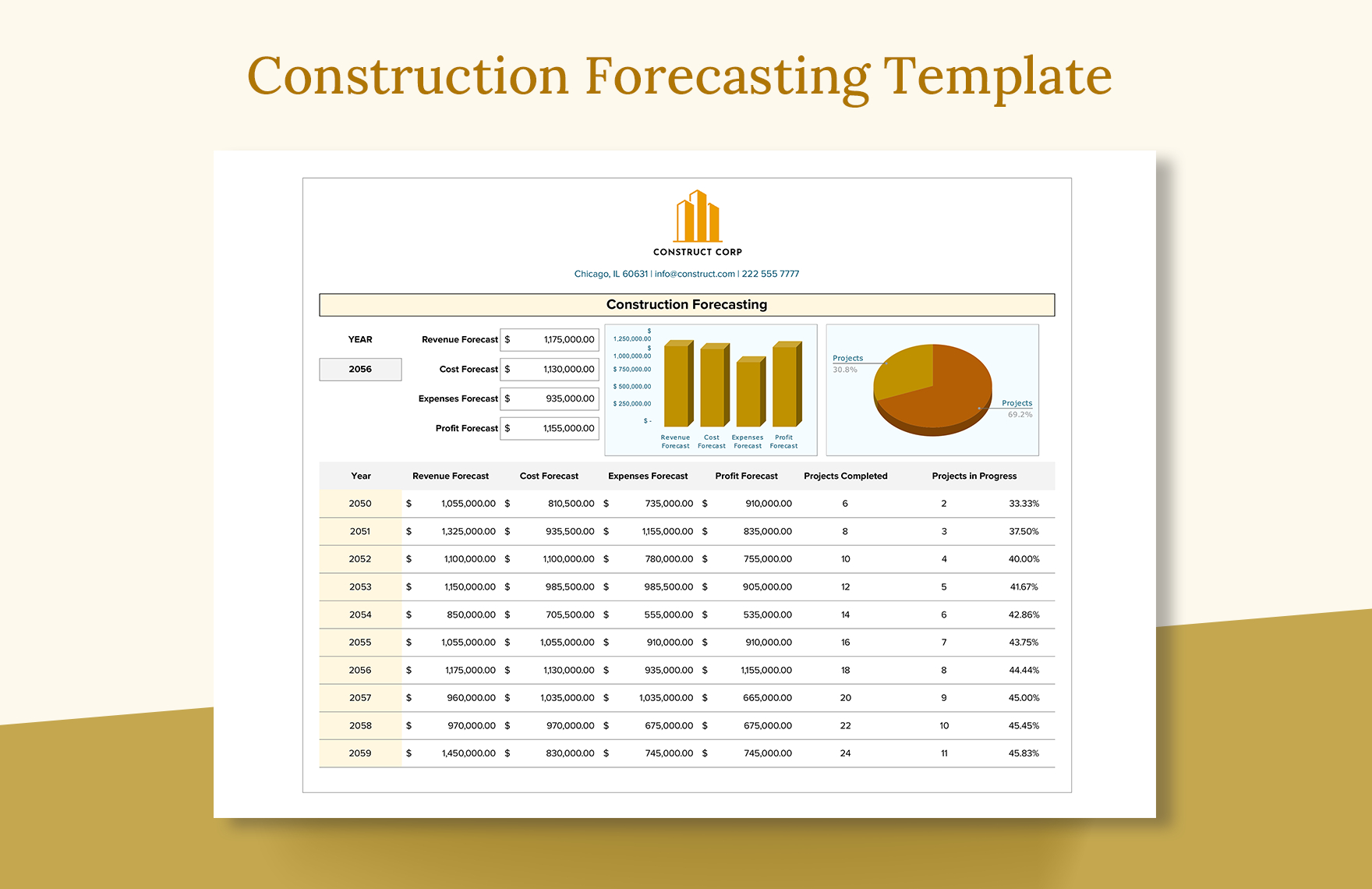
5. 5 Year Construction Financial Projections Template
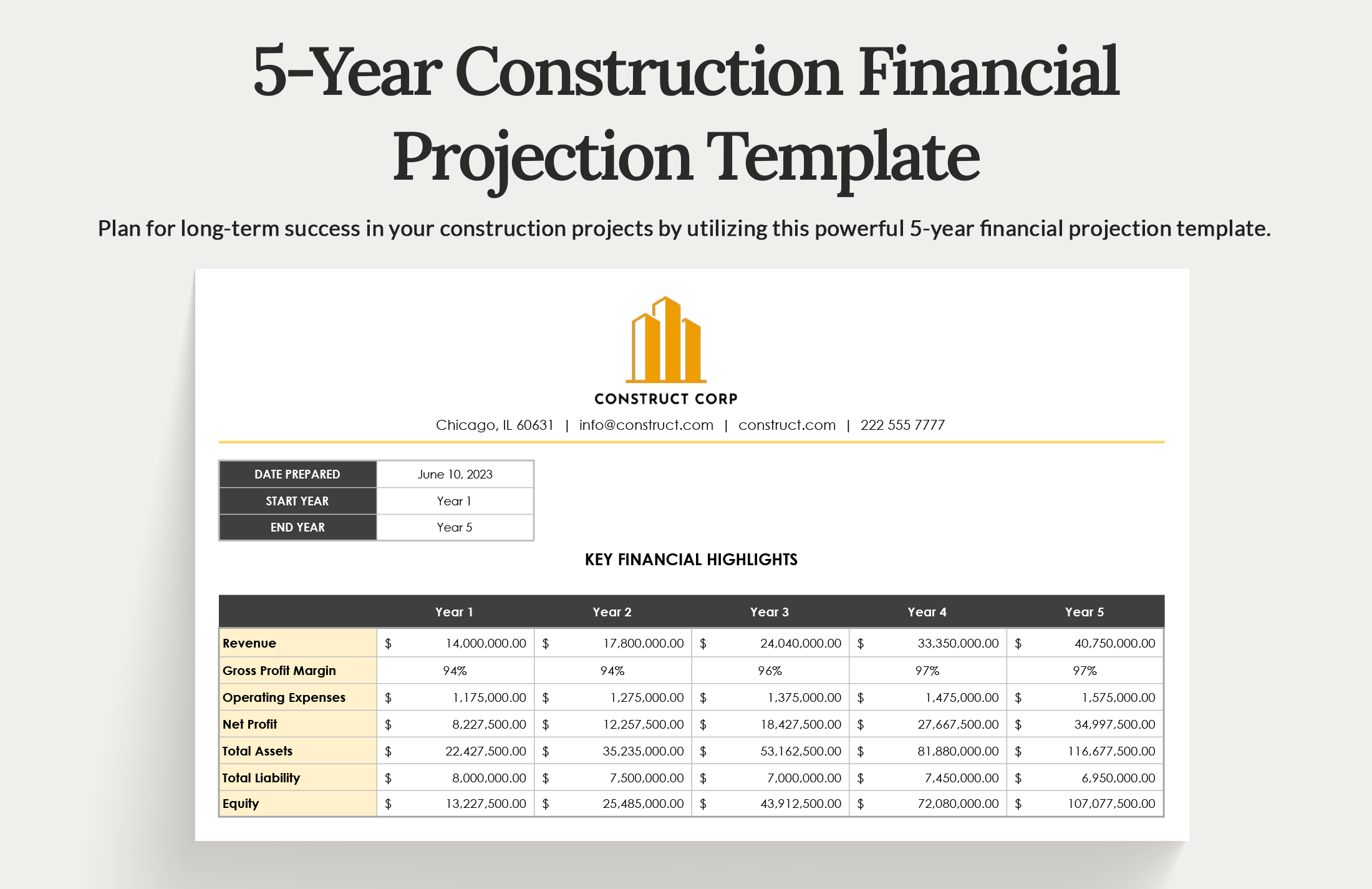
6. 3 Year Construction Financial Projections Template
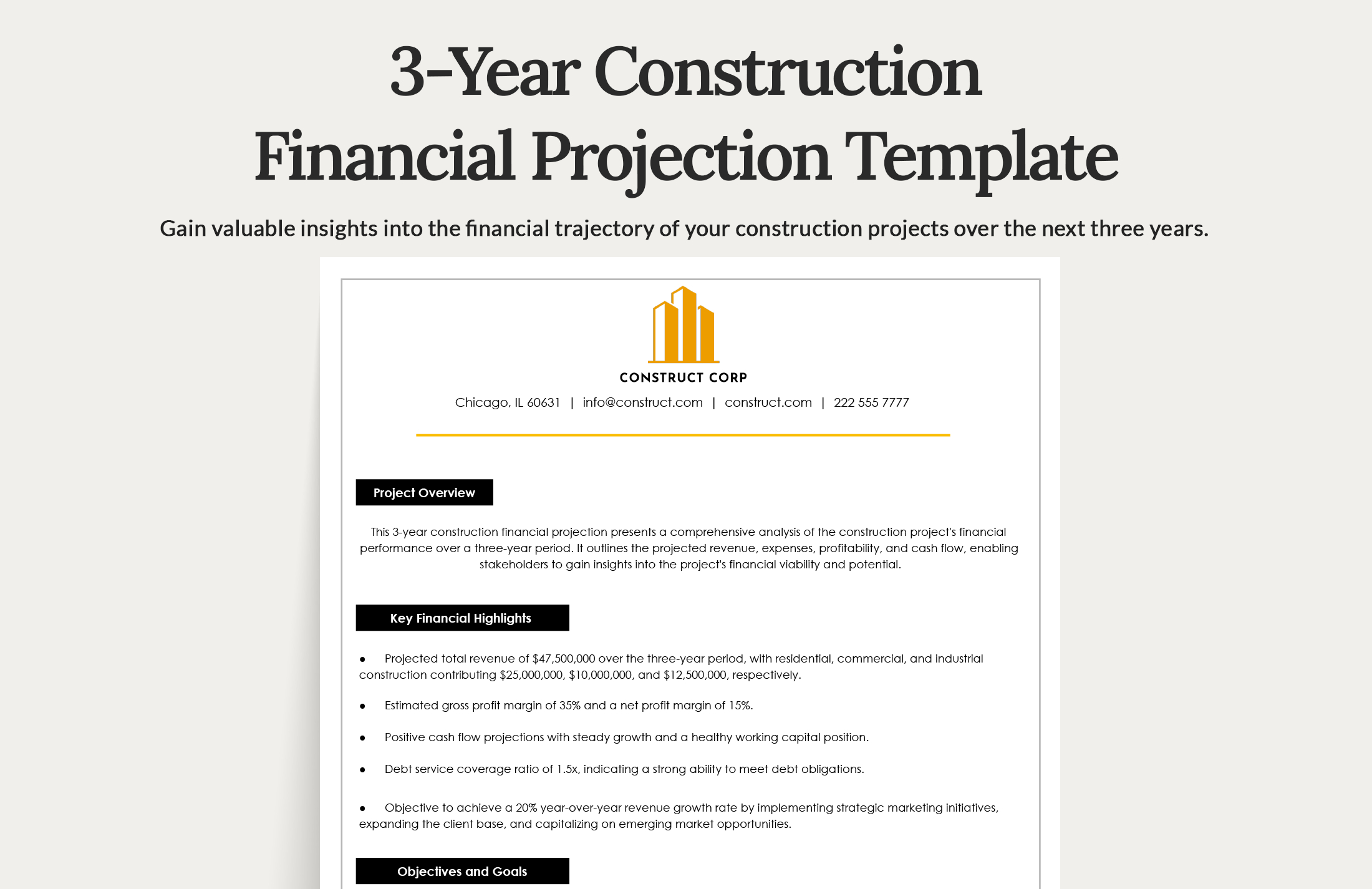
What are the Different Types of Construction Financial Projections?
The world of construction is vast and varied, and so is its financial landscape. Financial projections, the heart of any construction business plan, offer a sample roadmap to the monetary journey of a project. Depending on the nature, scope, and duration of the construction, these projections can take various forms.
Cash Flow Projections: The Lifeline of Construction
Arguably the most critical financial forecast for any construction project is the cash flow projection. This type of projection tracks the inflow and outflow of cash, ensuring that funds are available when needed. It allows managers to anticipate periods of cash surpluses and shortages, enabling them to plan accordingly.
Profit and Loss Projections: The Bottom Line
Profit and loss (P&L) projections offer a bird’s eye view of the project’s financial health. They detail the expected revenues, account for all anticipated costs, and then break down the projected profit or loss. In essence, the P&L projection gives stakeholders an idea of the venture’s profitability.
Balance Sheet Projections: The Financial Snapshot
A projected balance sheet offers a forecasted view of a company’s assets, liabilities, and equity at different stages of the construction. It provides stakeholders with insights into the firm’s financial position at various project milestones, ensuring that the company maintains a healthy balance between its resources and obligations.
Break-even Analysis: Finding the Equilibrium
Especially crucial for new construction ventures or projects with significant upfront costs, the break-even analysis determines the point where the project’s total revenues will equal its total costs. This projection helps stakeholders understand when they can expect to start seeing a return on their investment.
Sales and Revenue Projections: The Growth Curve
For construction firms handling multiple projects or venturing into new markets, sales and revenue projections become vital. They predict the expected sales and revenue generation, based on factors like market demand, contract values, and historical data.
Operational Expense Projections: Anticipating Costs
Every construction project comes with its set of operational expenses. These can range from labor costs, machinery hire, material procurement to administrative expenses. An operational expense projection allows for an in-depth look into these expected costs, ensuring budget adherence.
The Power of Scenario Analysis
Given the dynamic nature of the construction industry, many financial experts also employ scenario analysis. This technique creates multiple projections based on best-case, average-case, and worst-case scenarios. Such a holistic approach ensures preparedness for a range of possibilities.
Why is it Important for Construction Projections?
Just as an architect wouldn’t embark on a construction without a detailed blueprint, a construction manager wouldn’t proceed without detailed financial projections. These projections serve multiple purposes, ensuring the success and sustainability of a construction venture.
Ensuring Liquidity and Sustenance
Cash flow projections, in particular, ensure that the project doesn’t stall due to a lack of funds. With a clear idea of when and where cash is required, managers can maintain a steady flow of operations, meeting all financial obligations timely.
Mitigating Risks
Financial projections are also invaluable in risk management. By forecasting potential financial challenges, whether they’re unexpected expenses or revenue shortfalls, stakeholders can formulate strategies to mitigate these risks.
Informed Decision Making
With a clear financial roadmap, decision-makers can make more informed choices. Whether it’s deciding on the feasibility of a new project, negotiating with suppliers, or determining the project’s scope, detailed projections provide the necessary insights.
Securing Financing and Investment
For projects that require external funding, be it from banks, investors, or other financial institutions, having a robust construction business plan backed by detailed financial projections is often a prerequisite. These projections offer potential financiers the confidence that their investment is sound and that the firm has the capability to meet its financial obligations.
Monitoring and Accountability
Projections also serve as a benchmark. As the project progresses, actual financial outcomes can be compared against these projections. Any discrepancies can be identified and addressed, ensuring that the project stays on track, both operationally and financially.
Cultivating Stakeholder Confidence
Lastly, in the world of construction, reputation is everything. Clear and transparent financial projections foster trust. They show clients, suppliers, and other stakeholders that the firm is well-organized, financially prudent, and prepared for the journey ahead.
In essence, financial projections in the construction realm are not just about numbers. They are the foundation of trust, the pillars of sustainability, and the roadmap to success.
Related Posts
Building Inspection Report
Employment Certificate
Teacher Lesson Plan
Deed of Assignment
Contract Termination Letter
Student Research Proposal
Diet Plan
Housekeeping Resume
Marriage Proposal Letter
Nursing Resume
Fund Transfer Letter
Purchase Order Cancellation Letter
Certificate of Service
Employee Leave Form
Visitors Log